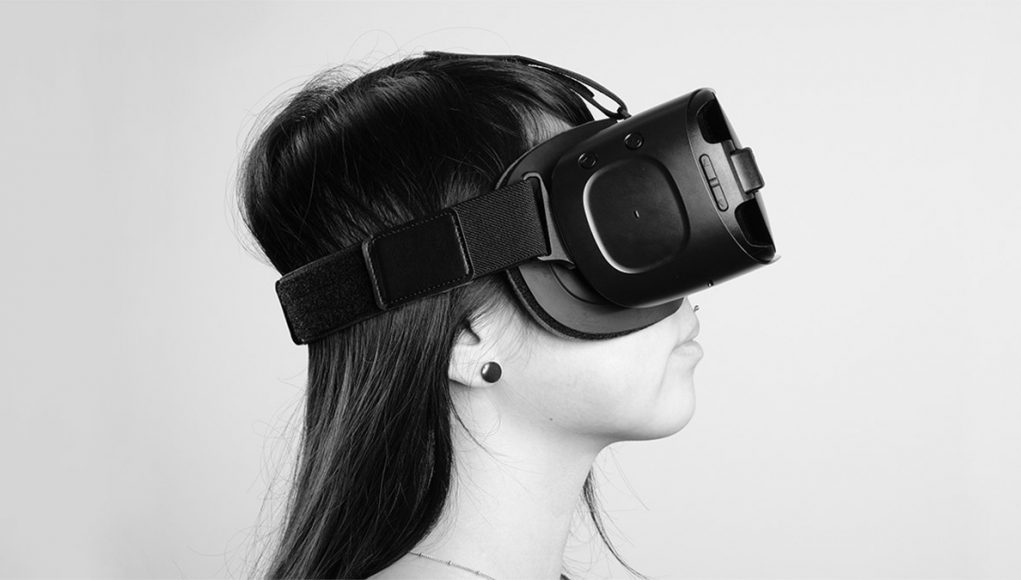Without explicitly announcing a new specific product, Samsung quietly implied that they may be developing a new standalone mobile VR HMD during a session during their developer conference last month. While there were no major VR announcements during the main keynote at SDC, in a session titled What’s on The Horizon: A Look at the Future of VR at Samsung, Tae Yong Kim, Samsung Electronics’ VP, Head of Graphics R&D, showed a graphic with a question mark in between a Gear VR mobile VR headset and a Samsung Odyssey Windows Mixed Reality HMD. Kim said that the Gear VR is “fully mobile, quickly attaches via a cell phone, and affordable” while the Odyssey offers a “premium experience coming from the positional tracking of the headset and the controllers, and the computing power of the PC.” He said, “The question is ‘How do we combine the benefits of those two technologies together for our next VR system?'”
Kim then showed a slide saying the next steps for Samsung’s mobile VR include inside-out tracking and 6 degree-of-freedom controllers, and he said, “We are partnering with global partners like Intel to bring inside-out technology to our next mobile product portfolio.” Neither Intel nor Samsung had any further comment about this quiet announcement of a “next VR system” and “next mobile product” in Samsung’s portfolio, which seems more significant than merely adding positional tracking and 6-DoF controllers to existing Gear VR devices.
It looks like we’ll have to wait until CES this year to learn if this is more than a positional tracking and 6-DoF tracking update to Gear VR, and whether Samsung is developing their own standalone headsets independent of Facebook’s Oculus Go. It’s unclear what software would be running on Samsung’s new headsets as it appears as though Samsung has a non-exclusive agreement with Oculus since the Samsung S8, S8+, and Note 8 are both Daydream and Gear VR-enabled, but it doesn’t appear that Facebook has a non-exclusive agreement with Samsung. Or if Facebook is able to expand to any OEMs beyond Samsung, then appears as though they have not done so yet. It could be that Facebook is planning a walled-garden hardware ecosystem similar to Apple, and will be focusing their energy on the control that comes with building their standalone headsets.
It’s unclear how healthy and sustainable the current partnership between Facebook and Samsung is. It appears as though Facebook mostly handles the software while Samsung handles the hardware, and while there’s obviously overlap between the two, it’s possible that these next HMDs will indicate whether Facebook takes more control over the hardware and Samsung takes more control over the software.
 I had a chance to talk with Samsung’s Tom Harding, who is the Director of Immersive Products in charge of product strategy and bringing VR to the market. We talked about the Gear VR, marketing VR, Samsung Internet VR, Gear 360 and Round cameras, the 3-DoF Gear VR controller, as well as the the collaborations Google with Daydream and ARCore and with Facebook/Oculus on Gear VR.
I had a chance to talk with Samsung’s Tom Harding, who is the Director of Immersive Products in charge of product strategy and bringing VR to the market. We talked about the Gear VR, marketing VR, Samsung Internet VR, Gear 360 and Round cameras, the 3-DoF Gear VR controller, as well as the the collaborations Google with Daydream and ARCore and with Facebook/Oculus on Gear VR.
LISTEN TO THE VOICES OF VR PODCAST
I challenged Samsung for not investing many resources within the VR content ecosystem or attending very many community VR events over the past couple of years. Harding says that Samsung’s focus has been on scale and making VR solutions available to all, and that they’ve been primarily focusing on driving adoption. But I wonder how much you can drive adoption of VR technologies without also investing in the content that will ultimately drive grassroots word of mouth and adoption.
A number of independent video creators expressed frustration that Samsung has not been doing more to support the needs of content creators, including how Samsung has not created any marketplace for immersive content creators to sell their work. One creator told me that Samsung did not not offer them any licensing fees to feature their work in the Samsung VR app, and a survey of content creators whose work was featured at Sumsung’s Evening of 360 show revealed that there was not any payment offered for featuring their work.
A lot of the content curation and marketplace development has been offloaded to Oculus since they serve as the primary point of contact with the VR development community, and so Samsung has been really disconnected from the needs of content creators. Samsung is in a financial position to invest a lot more within the future of the VR medium, but it appears as though that they have not been taking a holistic approach to supporting the VR content ecosystem or more directly engage the grassroots of the VR community. I hope to see Samsung a lot more in the year to come, and that they take the initiative to engage, listen, and help serve some of the larger needs of the VR community.
Support Voices of VR
- Subscribe on iTunes
- Donate to the Voices of VR Podcast Patreon
Music: Fatality & Summer Trip







